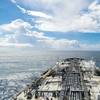Canada Ramps up Pressure on NY over BWT
Yesterday’s well-attended ballast water policy teleconference briefing by the Canadian Minister of Transport served notice that Canada has no intention of allowing the state of New York to dictate ballast water regulations, nor impede commerce on the St. Laurence Seaway.
The message delivered by Canada’s Parliamentary Secretary to the Minister of Transport, Infrastructure and Communities and for the Federal Economic Development Agency for Southern Ontario, Pierre Poilievre, was simple enough: we do not agree with the state of New York on ballast water issues and we will not allow our ocean commerce to suffer because of it. The teleconference, broadcast from Ottawa, provided a briefing on ballast water requirements on the St. Lawrence Seaway.
Poilievre told journalists on Thursday morning, “Canada is very concerned with the New York ballast water standard.” Referring to New York’s position of a ballast water treatment standard that is 100 times more stringent than the IMO’s soon-to-be-ratified benchmark, he added that New York’s position, if enforced, could shut down traffic, domestic trade and trade with the United States. Today, Poilievre is scheduled to be in New York to discuss Canadian concerns with New York stakeholders. He’ll follow that up with a similar trip to Washington “in the next several months,” he said; to do the same with U.S. federal counterparts.
In response to questions and advice that the State of New York had already admitted that it had neither the capacity nor the wherewithal to enforce any ballast water standards, Poilievre insisted that the issue was bigger than enforcement alone and went directly to insurance issues. He added that ship owners would be reluctant to transit Canadian waters where these border New York due to concerns over insurance cover.
Also according to Poilievre, Canada has two goals with regard to ballast water regulations, especially where it comes to its common border with the state of New York. First foremost, he said, “We want to keep the St. Laurence Seaway open.” Secondly, he added, the ultimate way to do this was to ensure “compatible regulations for all jurisdictions along the Seaway.”
Separately, the U.S. House of Representatives this week passed legislation that would supersede the myriad of balkanized U.S. state regulations now in play on the U.S. side of the border. The bill, one which proposes to set a national standard for ballast water regulation of vessels and additionally calls for the U.S. Environmental Protection Agency (EPA) to set minimum standards for organisms in ballast water that would mirror International Maritime Organization (IMO) benchmarks. No Senate version of the bill has yet been offered.
In the absence of a federal standard, more than 25 U.S. states have enacted their own standards, some of which have been called unachievable by scientists working on the problem. Meanwhile, the EPA’s Vessel General Permit (VGP) declaration has been promised by the end of this month. The long awaited U.S. Coast Guard BWT standard could also come before the end of the year. Both the Coast Guard and the EPA remain coy on what either standard will entail. Either or both could trigger litigation from individual U.S. states.
Earlier this year, Dennis King and Patrick Hagen – two scientists actively studying the issue of invasive species – quantified the estimated global cost of outfitting about 68,000 vessels with ballast water treatment systems at about USD $68 billion, or roughly $1 million per ship. Between 2012 and 2015, as many as 10,000 ships annually are expected to be fitted with BWT equipment. Canada’s very public declarations this week may well serve as the wake-up call for U.S. legislators and regulators that the issue, long simmering as a back-burner problem, is coming to a head. In the meantime, ship operators and ballast water technology manufacturers – neither looking to make an expensive mistake in advance of concrete rulings – both sit on the sidelines, watching anxiously to see the outcome.










